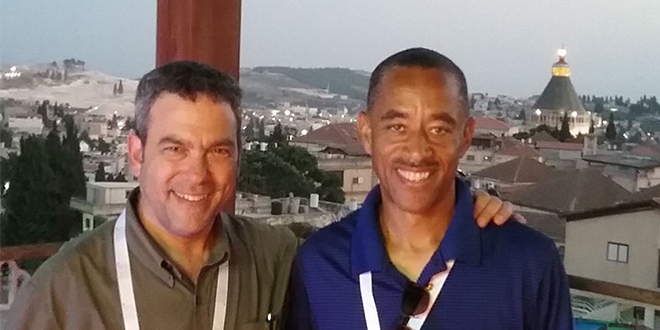09/28/2017
Rabbi Segar, Pastor Gibson Go On Peace-Oriented, Interfaith Israel Trip
- Share This Story
Article reprinted with permission from Cleveland Jewish News.
By Amanda Koehn

Rabbi Steve Segar, left, and Pastor Richard M. Gibson visit Nazareth, Israel.
Rabbi Steve Segar of Kol HaLev in Pepper Pike and Pastor Richard M. Gibson of Elizabeth Baptist Church in Cleveland are well acquainted with exploring social justice issues together.
They first met when Gibson was a guest social justice speaker during Yom Kippur services a few years ago at Segar’s temple. And just a month ahead of this year’s High Holy Days, they went on a trip together to Israel and the Palestinian territories, with similar social justice themes, but as they pertain to the Middle East countries.
The 21-person trip was put on by Interfaith Partners for Peace, a network that pairs Jewish and non-Jewish clergy to engage in grassroots activism toward the Israeli-Palestinian peace process. The August trip was intended to engage African-American ministers in the issues, Segar and Gibson said. It attempted to address the Israeli-Palestinian conflict from a balanced perspective, as well as interracial dynamics in Israel, and included visits to Christian holy sites and the Palestinian city of Ramallah.
Segar, who lived in Israel in the late 1980s but hadn’t returned since he led a Joseph and Florence Mandel Jewish Day School eighth-grade trip in 1999, said the visit and exposure to grassroots groups working toward peace gave him hope.
“I would think people in both the Jewish and Palestinian diasporas might be interested in supporting these efforts that are helping to humanize people on both sides of the conflict, and in some cases, really make a contribution to the well-being of the present and future of hopefully what will be eventually a two-state situation,” Segar said.
IP4P is run by the Israel Action Network, an effort between the Jewish Federations of North America and the Jewish Council for Public Affairs. Executive Director of the Israel Action Network Ethan Felson said they try to engage a broad range of perspectives on trips like this one.
“We hear uncomfortable things on either side, and we try to turn to shared society perspectives – people who are working across the divides together as Jews and Arabs,” Felson said.
Gibson, who became involved with the trip through the Jewish Federation of Cleveland, also visited Israel 10 years ago, however he had never been to the West Bank before. He said going there decreased some of the differences he had previously perceived between Israeli and Palestinian life and development.
“I was encouraged, because while there are still some differences, I don’t think those differences are as distinct as I would have imagined based on what I saw previously,” he said.
However, he said this trip gave him a sense of the true complexity of the conflict he hadn’t recognized in the past.
“I walked away with a sense that the conflict is even more complex than I had already imagined, and I never thought it was a simple conflict at all,” he said, adding, however, that he felt encouraged that he saw people working to mediate it.
Segar also said he hadn’t visited the West Bank previously and was surprised by the development in Ramallah, citing car dealerships, stores, hotels and big buildings that line the city were not what he expected.
“In my mind’s eye, all of the Palestinian life in the West Bank, I imagined it being very challenged economically,” Segar said, adding that the city could be “the exception that proves the rule” for the rest of the West Bank.
Noting the trip began Aug. 14, just following the violent white supremacist rally in Charlottesville, Va., the group felt a heightened sense of awareness around interracial relations, Gibson said. The trip explored the integration of Ethiopian Jews into Israeli society, and Gibson said he saw some similarity in the high rates of incarceration and police brutality toward Ethiopian immigrants in Israel and African Americans in the United States.
However, he said issues of race and class in regard to policing and job access, among other issues in the two countries, likely require somewhat different solutions because of the cultural and environmental differences.
“I don’t believe that I can apply a U.S. lens to interpret what’s going on in Israel,” Gibson said. “I think there are some parallels, but I think there are more differences than parallels.”
They also met with a group called Sikkuy that has a program to close the funding gap between Jewish Israelis and Palestinian Israelis, where Segar said, “Jewish citizens have gotten a per capita, much higher percentage of government assistance than Palestinian citizens have,” and he believes has occurred since the founding of the country.
“(Sikkuy) has worked very hard to bring this issue to the attention of the Israeli government, and to their credit – to the credit of the organization and to the government – they are now making efforts to close that gap,” Segar said. “I think that gap is a reflection of a kind of racial and ethnic divide in Israel between Israeli Jews and Israeli Palestinians.”
Although Segar and Gibson previously held joint congregational events, the trip inspired them to do more together, specifically toward uniting over their peoples’ common histories of oppression. They are currently planning a joint-congregational trip to the National Museum of African American History and Culture and the U.S. Holocaust Memorial Museum, both in Washington D.C.
Also, during the interview, Segar asked Gibson about potentially supporting an Israeli-Palestinian “coexistence project” their congregations could choose together, to which Gibson agreed.
“Next steps are important,” Gibson said.


Comments